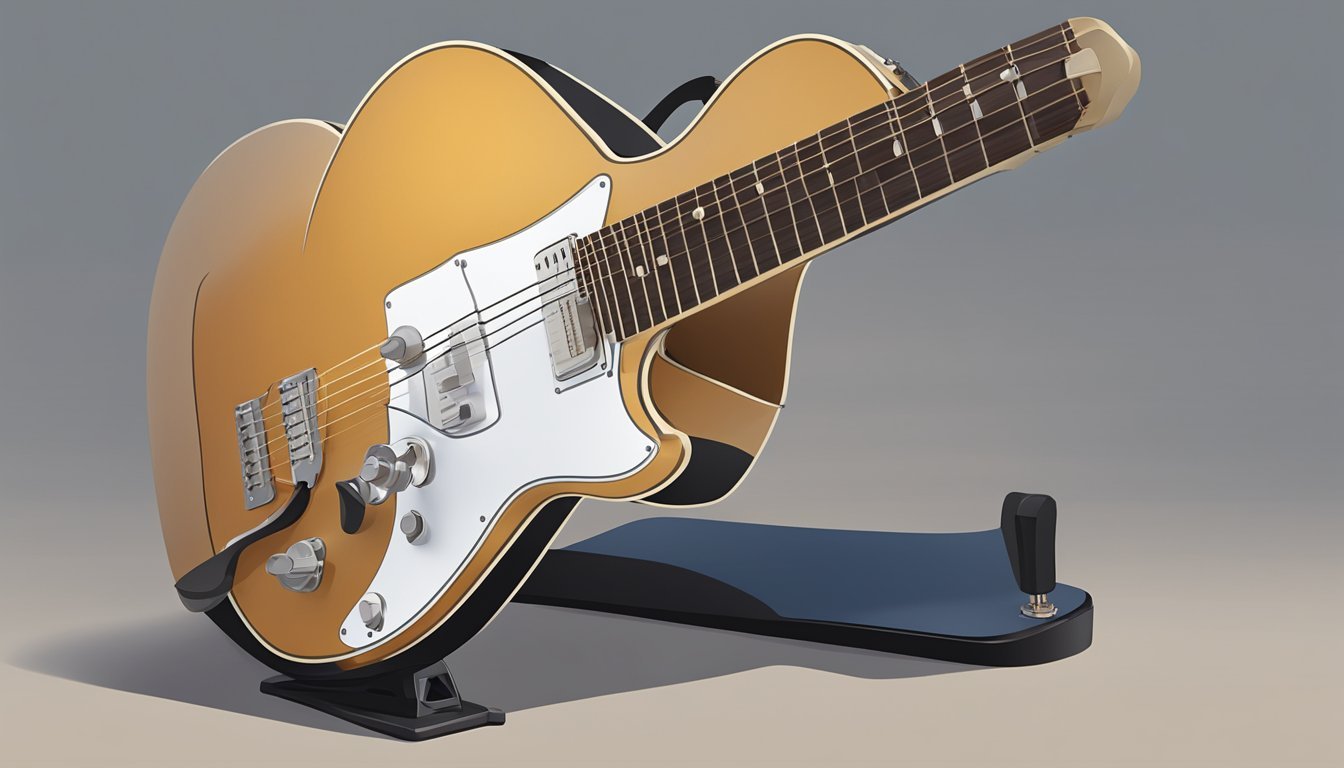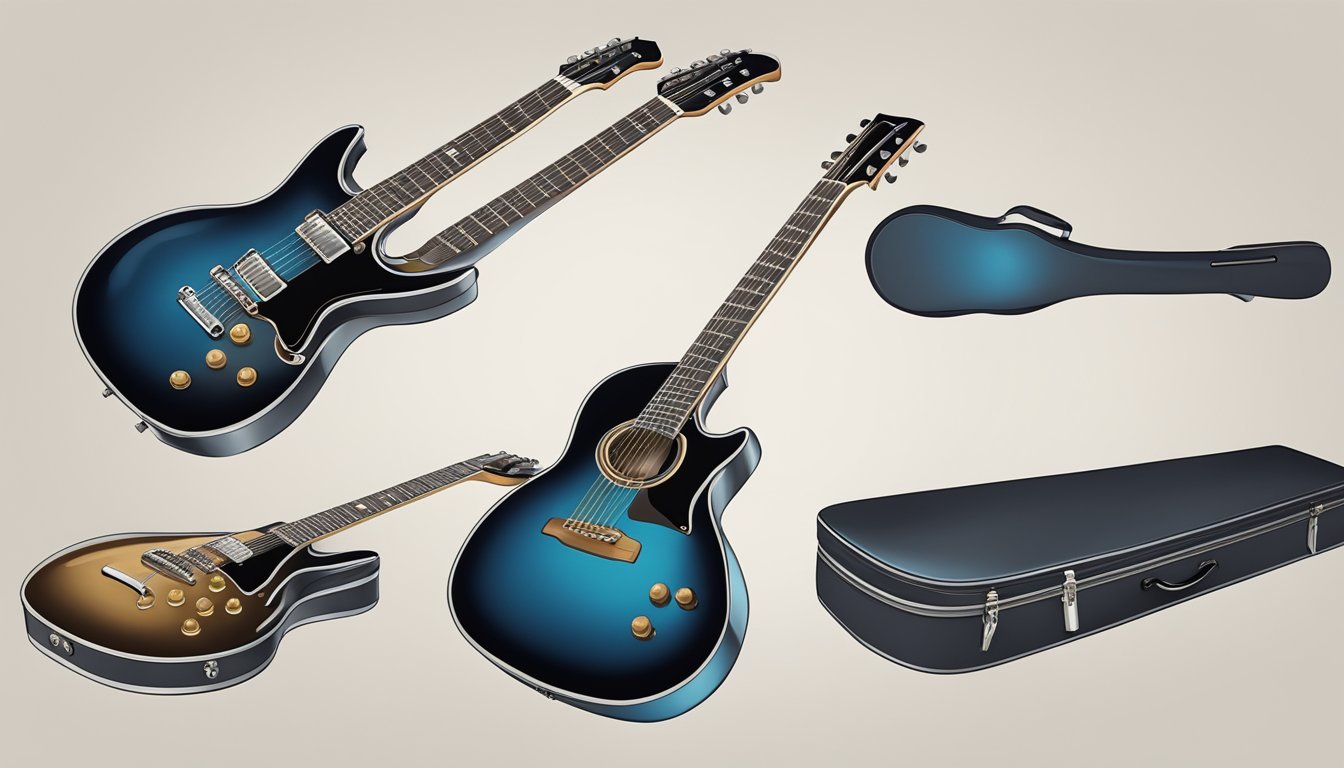Holding a guitar properly is essential for both comfort and skill.
To hold a guitar effectively, you should secure the body with your strumming hand’s elbow, angle the neck slightly upward, and keep your fretting hand relaxed.
If you’re new to playing or just want to refine your technique, knowing the right posture can make a big difference in how you play.

As you get comfortable with your guitar, remember that good posture helps prevent strain and allows you to play longer.
Simple adjustments can improve your overall technique, making your practice sessions more enjoyable.
By learning the basics of holding your guitar, you set yourself up for success and create better habits from the start.
Finding your groove will take practice, so don’t rush the process.
Stay patient, keep your hands relaxed, and focus on maintaining a good posture while playing.
Comfortable holding techniques can elevate your playing and help you enjoy the music you create even more.
Key Takeaways
- Proper guitar posture reduces strain and improves technique.
- Relaxed hands contribute to better playing performance.
- Regular practice of good posture habits enhances your skills.
Getting Comfortable with Your Guitar

Getting comfortable with your guitar is key to improving your playing.
The right setup helps you maintain good posture and stay relaxed.
Here’s how to find a comfortable position.
Choosing the Right Chair or Stool
Finding a good chair or stool is really important.
You want something that’s stable and allows you to sit at the right height.
Consider a chair that has no arms so your arms can move freely.
A stool can also work, especially if it’s the right height.
Tip: Your feet should rest flat on the ground or on a footstool.
This alignment keeps your back straight and your posture good.
Try to avoid chairs that are too soft or too low.
They can make it hard to support the guitar properly.
Sitting Position Explained
When you sit with your guitar, keep your back straight and shoulders relaxed.
Try not to lean too far forward or slouch.
There are two main positions for holding the guitar while sitting: the casual and classical styles.
In the casual style, the guitar rests comfortably on your right leg.
The neck points slightly upward.
In the classical style, place the guitar on your left leg with the neck angled more upwards.
This helps access the fretboard easily.
Remember: A good sitting position promotes good posture and helps prevent fatigue.
Using a Guitar Strap
Using a guitar strap can really help, even when sitting.
It supports the weight of the guitar and keeps it in place.
When using a strap, make sure it’s adjusted to the right length.
The guitar should sit comfortably against your body, easy to reach the fretboard.
A strap also allows for more movement.
You can stand up without worrying about your guitar slipping.
Tip: When adjusting your strap, try different lengths to find what feels best.
Your comfort is key.
Positioning the Guitar Footstool
A guitar footstool can be a game-changer, especially for classical guitar players.
It elevates your foot, allowing for a better angle when holding the guitar.
Place the footstool under your left foot if you’re using the classical sitting position.
This helps keep the guitar closer to your body.
A footstool also supports good posture.
Your back stays straight, and your legs won’t tire as quickly.
Note: If you don’t have a footstool, a sturdy box can work in a pinch.
Just make sure it’s stable!
The Basics of Holding Your Guitar
Holding your guitar properly is key to playing well.
It affects your comfort and how easily you can access the strings and fretboard.
Here’s what you need to know about positioning your hands and body for the best playing experience.
Hand and Finger Placement
Your hands should be relaxed.
Start with your fretting hand, which is usually your left hand.
Place your thumb on the back of the neck for leverage.
Your fingers should curve naturally, making it easier to press down on the strings.
Make sure your fingertips contact the strings directly.
This will help you produce a clear sound.
Keep your knuckles slightly bent and avoid collapsing them.
For the right hand, hold the pick between your thumb and the tip of your first finger.
Your hand should stay relaxed.
Aim for a comfortable grip that allows for smooth strumming.
Guitar Neck and Fretboard Orientation
When you hold the guitar, angle the neck slightly upwards, around 45 degrees.
This angle helps you see the fretboard better.
It also aids in finger placement, making it easier to reach each fret without straining.
Your wrist should remain straight while your fingers press down on the strings.
Otherwise, you risk cramping or causing tension.
Check that your fretting hand is positioned so that your fingers can access multiple frets easily.
Keeping the neck in this position will support better playing and allow you to learn chords faster.
Adjusting Your Posture for Comfort
Good posture is crucial for long practice sessions.
Sit up straight with your back aligned.
Your guitar should rest on your dominant side, either your right or left leg, depending on your handedness.
If you’re seated, try to use a guitar strap to keep the instrument steady.
It helps you maintain balance while playing.
Ensure that your left wrist is relaxed to avoid strain.
When you practice standing, adjust the strap so the guitar hangs comfortably on your body.
This will allow you to move freely and keep a good hand position.
Techniques for Effective Guitar Playing
Getting the hang of effective guitar playing is key to improving your skills.
Focus on how you strum, position your fretting hand, and avoid common mistakes.
These techniques can make your practice sessions more productive and enjoyable.
Strumming Like a Pro
To strum effectively, keep your wrist relaxed.
Use small, gentle movements rather than stiff arm motions.
This helps you maintain control and produce a smooth sound.
You might start by using just your thumb or a pick.
Experiment with different strumming patterns.
Start with a simple downstroke and then mix in upstrokes.
You can try techniques like palm muting for varied dynamics.
Don’t forget to practice slowly before speeding up.
This builds muscle memory and keeps you from developing poor habits.
Consistent practice will lead to more fluid strumming and fewer mistakes over time.
Fretting with Ease
Your fretting hand plays a major role in producing clean notes.
Keep your fingers curved and press down just behind the fret wire.
This ensures clear sounds without unnecessary buzzing.
Use your fingertips rather than the pads to make contact with the strings.
It minimizes the pressure needed.
Remember to keep your thumb positioned at the back of the neck for balance and support.
Also, practice moving between chords slowly.
This helps to build strength and dexterity.
Over time, you’ll find transitions become smoother, which is essential for playing songs seamlessly.
Avoiding Common Mistakes
Many beginners struggle with injuries from improper technique.
Common issues include repetitive strain injury (RSI) or carpal tunnel syndrome (CTS), often due to bad posture or grip.
Make sure your posture is correct while playing.
Sit up straight and keep the guitar at a comfortable angle.
Your strumming hand should have a natural motion without straining your wrist.
Additionally, watch out for pressing too hard on the fretboard.
This can lead to unnecessary fatigue.
Take breaks during practice to rest your hands and avoid long sessions to prevent injuries.
By staying aware and adjusting as needed, you can keep playing comfortably.
Practice and Maintenance Tips

To improve your guitar skills and keep your instrument in top shape, it’s important to have a regular practice routine and take good care of your gear.
Also, preventing fatigue and injuries while playing will help you enjoy your music more.
Incorporating Regular Practice Routines
Setting a regular practice schedule is crucial.
Aim for at least 30 minutes a day, mixing scales, chords, and songs.
Consistency helps develop muscle memory and improves your playing technique.
Break your practice time into short segments.
For example, spend 10 minutes on warm-ups, 10 on new chords, and the last 10 on songs you love.
This makes practicing less overwhelming and keeps it fun.
Take notes on your progress to stay motivated.
Write down what you practiced and any challenges you faced.
This helps track your growth and identify areas needing extra attention.
Caring for Your Guitar Strap
A good guitar strap is essential for comfort during practice and performances.
If you’re using a leather strap, keep it clean with a damp cloth.
Avoid harsh chemicals as they can ruin the leather’s finish.
Check your strap pegs regularly.
Make sure they’re tightly secured to prevent the strap from slipping off while you play.
If you notice any wear, consider replacing them to avoid accidents.
Store your strap in a dry place to prevent mildew or damage.
If possible, choose a strap that suits your style and feels good on your shoulder, as this will make longer practice sessions much more enjoyable.
Preventing Fatigue and Injuries
To avoid fatigue and injuries, posture is key.
Sit or stand upright while playing.
Slouching can lead to neck and back pain over time.
Keep your shoulders relaxed and avoid tensing up your hands.
Take breaks during longer practice sessions.
A quick stretch can do wonders for your muscles.
Shake out your hands and arms to relieve tension.
If you start feeling discomfort, stop and assess your position.
Adjust your grip, and make sure your guitar is at a comfortable height.
This can prevent strain and keep your playing enjoyable for hours.
Frequently Asked Questions
When you’re figuring out how to hold a guitar, there are some common questions that pop up.
Whether you’re trying to get the feel right or just looking for tips, these answers will help you get more comfortable with your instrument.
What’s the proper way to hold an acoustic guitar?
To hold an acoustic guitar, sit comfortably with the guitar resting on your right leg.
Keep your back straight and let the body of the guitar sit against your torso.
Your right arm should drape over the top, ready to strum, while your left hand is free to move along the neck.
Any tips for holding a guitar pick correctly?
Hold the pick between your thumb and the tip of your index finger.
It should stick out slightly, allowing you to strum with ease.
Keep your hand relaxed to avoid tension, which can make playing harder than it needs to be.
How should you grip the neck of a guitar?
When gripping the neck, use your thumb to anchor behind it.
Your fingers should arch over the fretboard without pressing too hard.
This allows for quick movement between frets and makes it easier to play chords without strain.
Can you give me pointers on holding a guitar if I’m a lefty?
If you’re left-handed, you might want to play a left-handed guitar, which has the strings and neck arranged for your dominant hand.
Hold it similarly to how right-handed players do, just flipped.
Keep your arm relaxed and find a comfortable position for your left hand on the neck.
This adjustment not only makes playing more natural but also allows you to develop your skills more effectively.
As you practice, focus on how to hold a guitar correctly to ensure you’re maximizing your playing potential while minimizing tension.
Remember to experiment with different hand positions to find what feels best for you.
For a total newbie, what’s the basic way to hold an electric guitar?
The basic way to hold an electric guitar is similar to an acoustic.
Sit or stand with the guitar body resting on your right leg.
If you’re standing, let it hang at a comfortable height.
Keep your arms relaxed, and make sure you can reach the frets easily.
What’s the right posture for playing guitar chords?
When you play chords, sitting up straight can help with breathing and control.
Keep the guitar close to your body and make sure your shoulders are relaxed.
This posture will help you reach the strings better and make it easier to switch between chords.

